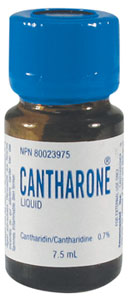
|
|
|
|
Cantharone Products are not approved for sale or use in the United States
|
HIGH POTENCY WART REMOVER FOR DOCTOR USE ONLY
- MOLLUSCUM CONTAGIOSUM
- COMMON WARTS
- PERIUNGAL WARTS
Important:TO BE APPLIED ONLY BY A PHYSICIAN. Due to its toxicity and potential
for misuse, CANTHARONE® is not recommended for dispensing or prescribing to patients.
Poisonous, may be fatal if ingested. For external use only.
|
Features:
- Simple office procedure, no special instrument required
- A selective procedure not randomly destructive
- Painless application
- Produces a uniform blistering action
- Leaves no permanent scars
|
|
Description:
CANTHARONE®, cantharidin collodion is a topical liquid containing 0.7% cantharidin
in a film-forming vehicle containing acetone, collodion, castor oil and camphor.
The active ingredient, cantharidin, is a vesicant. The chemical name is: Hexahydro-3a,7a-dimethyl-4B,7B-epoxyisobenzofuran-1,
3-dione (C10 H12 O4)
|
|
INDICATIONS AND USAGE:
CANTHARONE® is indicated for removal of common warts, molluscum contagiosum and
periungal warts. It is designed for topical application by a physician. Painless
application and the absence of instruments makes it especially useful for treating
children (some pain may occur later).
|
|
CLINICAL PHARMACOLOGY:
The vesicant action of cantharidin is the result of its primary acantholytic action.
Its effectiveness against warts is presumed to result from the “exfoliation” of
the tumor as a consequence of its acantholytic action. There are no reports of scarring
when cantharidin is used alone as directed, presumably because the lytic action
of cantharidin does not go beyond the epidermal cells. The basal layer remains intact
and there is minimal effect on the corneum.
|
PRODUCT USE
BEFORE USING, PLEASE REVIEW THE WARNING AND CAUTION INFORMATION IN THE PACKAGE
TREATING WITH CANTHARONE®
- Molluscum contagiosum: On the first visit, treat only a few lesions until the sensitivity
of the patients is known, then multiple areas can be treated in one visit. Using
a pointed wooden stick, apply a very small amount of solution to only the top of
each lesion. Let dry completely. No occlusive tape or dressing is needed (but may
be used). Alert patient that blistering is the desired result and that temporary
hypopigmentation may occur. The patient may bathe after 4 to 6 hours; sooner if
discomfort occurs. Blisters are usually formed by about 24 hours, and crust up in
about four days. Mild discomfort or itching can usually be controlled with bathing
and night time sedation. In one week, treat any new lesions the same way and retreat
any resistant lesions with CANTHARONE®, this time recovering with a small piece
of non-porous plastic tape. The tape should be removed in 4 to 6 hours or sooner
if discomfort occurs.
- Common and periungal warts: No cutting or prior treatment is required (occasionally
nails must be trimmed to expose subungual warts to medication). Using a pointed
applicator stick, apply CANTHARONE® directly to the lesion; be sure to cover the
growth completely, extending beyond by about 1 mm. Allow a few minutes for a thin
membrane to form and cover with a piece of non-porous plastic adhesive tape, e.g.
Blenderm®. (taping with occlusive tape is important for full activity). Instruct
patient to remove tape in 24 hours and replace with a loose Band-Aid®. On next visit,
(1 or 2 weeks), remove necrotic tissue and re-apply CANTHARONE® to any growth remaining.
A single application may suffice for normally keratinized skin.
- PLANTAR WARTS: Prior to the treatment, thoroughly clean the surrounding skin to
assure goodadhesion of the occlusive tape. Proper taping with non-porous plastic
tape is an important part of the procedure. Pare away keratin covering the wart;
avoid cutting viable tissue. Using a pointed applicator stick, apply CANTHARONE®
to both the wart and about 1 to 3 mm margin around the wart. Allow a few minutes
to dry. Secure with a non-porous plastic adhesive tape directly on the treatment
site. A doughnut pad over the tape may be helpful. Then secure everything in place
using additional tape. After 24 hours, the patient may bathe and replace the dressing.
Debride one to two weeks after the treatment. If any viable wart tissue remains
after debridement, re-apply a small amount of CANTHARONE® and bandage as above.
Three or more such treatments may be required for large lesions. For large mosaic
warts, treat a portion of the wart at a time. Applying CANTHARONE® to open tissue
will result in stinging from the solvent. This can usually be avoided if paring
is done carefully and treatments are two weeks apart. When destruction of the wart
is complete, the healed site will appear smooth, with normal skin lines.
|
SUMMARY OF USE
CANTHARONE® AND CANTHARONE® PLUS
- Both products are very potent, use sparingly. Treatment is at 10 days to 2 week
intervals. Delay treatment if inflamed.
- Both products are to be used under occlusion with a non-porous tape, e.g.Blenderm®,
occlude no longer than 8 hours with CANTHARONE® PLUS and 24 hours with CANTHARONE®
- Note: Tape is not normally used when treating molluscum
- Sterile puncture of the blister will help relieve discomfort and should be done
at the discretion of the physician.
- Daily soaks are at the discretion of the physician. It is recommended to use a mild
anti-bacterial soap until tissue re-epithelializes.
|
|
Warning
Cantharone and Cantharone Plus are for physician use only. They should not be dispensed
or prescribed for patient administration under any circumstances.
|
|
|
|
|